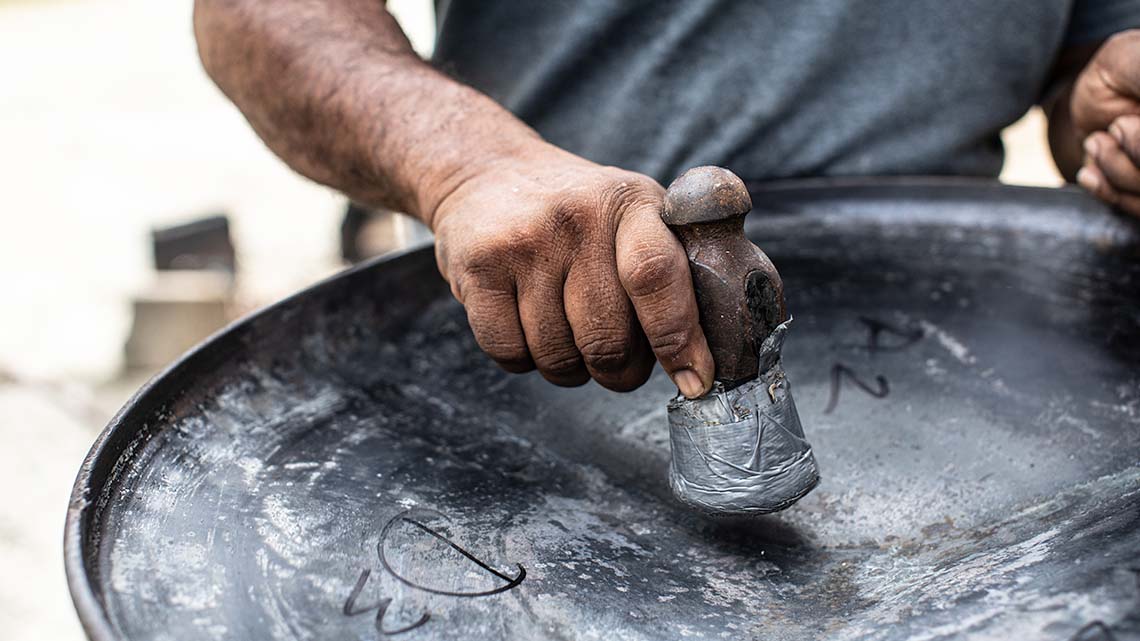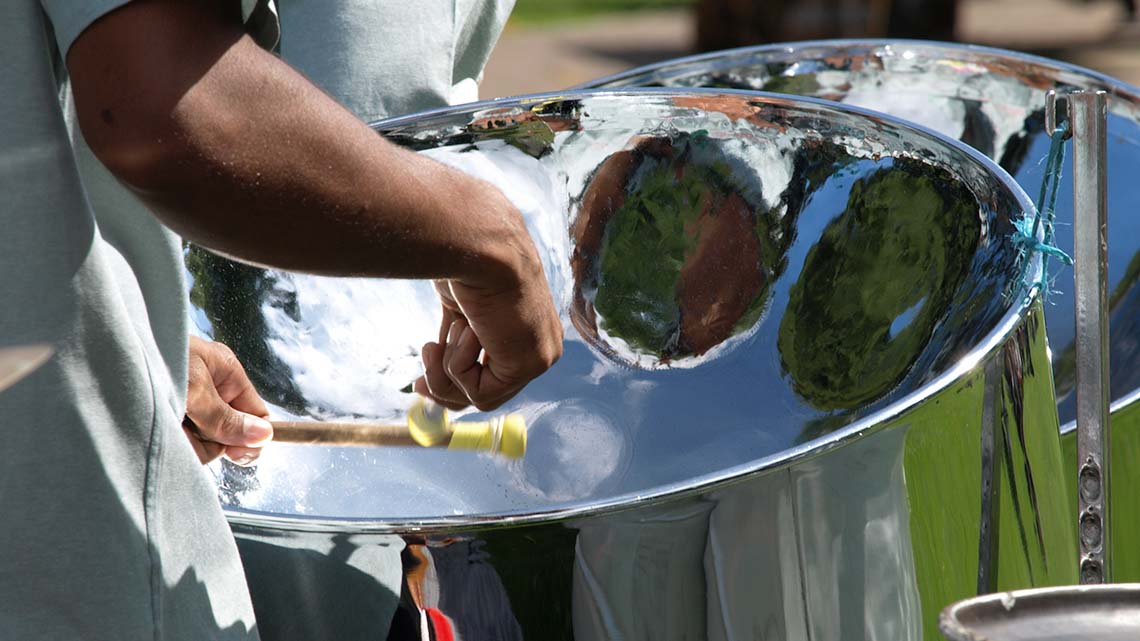Minds On
Today’s vocabulary
Press the following tabs to access today’s vocabulary.
- The sound produced when two or more instruments or voices play or sing the same pitch.
- The interval that occurs when two melodic parts (voices or instruments) join to produce the same sound.
Making music in creative ways
Sometimes, music can be produced from unexpected sources. People can use their own bodies to create rhythms, or even try “playing” non-musical objects as though they were instruments! One famous example of how an everyday item was successfully transformed into an instrument is the “steel pan”.
In Trinidad in the 1930s, musicians invented a creative way to reuse old industrial objects like car parts, oil drums, and paint pots made of metal. They first experimented by hammering dents into the metal surface of the objects, and then striking the dented metal with a drumstick. What they noticed was that when hit with a drumstick, these dented oil drums could produce the sound of different musical pitches!
This discovery evolved into the instrument now known as the “steel pan”. Even though its music can be enjoyed around the world today, the steel pan will always be an important symbol of Trinidadian culture and history.
Explore the following video entitled Backyard Beats: ‘Steelpan’ to check out a musician named Joy Lapps playing an arrangement entitled “Sweet” on the steel pan:
Reflect on the following questions:
- What do the other two performers Monica and Junior Jammer Monica do in the performance?
- How do they accompany Joy’s melody on the steel pan?
Record your thoughts using a method of your choice.
Action
Get ready, get set…
While Joy created a melody on the steel pan, the two supporting performers were keeping the rhythm.
What is rhythm?
Rhythm in music is patterns of long and short sounds or silences combined. Patterns can be created by both musical sounds and lyrics or words. Rhythm is different from beat; for example, the rhythm at the beginning of a song might be “ta, ti-ti, tika-tika, ta”, while the beat is the underlying steady pulse of “ta, ta, ta, ta”. Explore the following images to compare the rhythm with the beat.
- ta = quarter note
- titi = eighth notes
- tika-tika = sixteenth notes

A musical bar with a quarter note, two eighth notes, four sixteenth notes and a quarter note. The notes are labelled 'ta, ti-ti, tika-tika, ta.'

Access the following audio recording entitled “The Rhythm” to explore the rhythm of the steelpan performance.
The Rhythm
Check out the following audio recording entitled “The Beat” to explore the beat of the steelpan performance.
The Beat

Two teachers discussing. The first teacher shares: ‘I’m not sure I understand, Teacher B. Were Monica and Junior Jammer Monica “keeping the rhythm” even at the start when they didn’t have instruments?’ The second teacher responds: ‘That’s right, Teacher A! Since rhythm is simply the pattern of long and short sounds (or silences), we don’t actually need any kind of instrument or technology to create one.’ The first teacher responds: ‘Hmm, so it’s really all about the pattern? The second teacher responds again: ‘Exactly. Of course, we can create rhythms with instruments too, but Monica and Monica showed how we can express a rhythmic pattern using only our bodies!’ The first teacher replies: ‘Wow! Is there a special name for that?’ The second teacher answers: ‘There is! It’s called body percussion.’
What is body percussion?
The human body can be an instrument all on its own! Body percussion describes movements that use various parts of the body to produce rhythmic sounds. For example, someone might:
- stomp
- pat
- clap
- snap
- click tongue
Explore the following video entitled “The Percussion Show: Body Percussion” for examples of how diverse types of body percussion can create a rhythm.
Consider the following questions, and record your ideas using a method of your choice:
What body movements did the performers use to make a rhythm?
Press ‘Answer’ to access a possible answer
They used their feet to create a stomping sound, they patted their hands on their knees and chest, and clapped their hands together to create different patterns or rhythms.
What could you notice about the kind of patterns or rhythms they created together?
Press ‘Answer’ to consider a possible answer.
The performers did not follow the same pattern throughout but instead followed a few different rhythms of different paces and body percussion styles. They began the video by playing a rhythm in unison.
What is a unison?
Unison is the sound produced when two or more instruments or voices play or sing the same pitch or tone. Please note that our bodies can also count as percussion instruments!
Go!
Let’s explore different rhythms in 4/4 time.
4/4/ time
4/4 time - A time signature of 4/4 means that all of the notes in each bar of music must add up to 4 quarter notes. The pulse or beat is counted as 1, 2, 3, 4.
Check out the following three rhythms. Each of the rhythmic phrases are in 4/4 time.

A musical bar in 4/4 time. The bar has a rhythm created with musical notes. The musical notes are a quarter note, eighth-sixteenth notes, sixteenth-eighth notes, and a quarter note. The notes are labelled ‘ta ti-tika tika-ti ta’.
Access the following audio recording entitled “Rhythm 1” to check out the rhythm.
Rhythm 1

A musical bar in 4/4 time. The bar has a rhythm created with musical notes. The musical notes are three sixteenth-eighth notes and a quarter note. The notes are labelled ‘tika-ti tika-ti tika-ti ta’.
Explore the audio clip entitled “Rhythm 2” to learn more about the rhythm.
Rhythm 2

A musical bar in 4/4 time. The bar has a rhythm created with musical notes. The musical notes are a quarter note, eighth notes, eighth-sixteenth notes and a quarter note. The notes are labelled ‘ta ti-ti ti-tika ta’.
Check out the following audio recording entitled “Rhythm 3” to explore the rhythm.
Rhythm 3
Explore each rhythmic phrase along with the audio recording and description. If possible, try playing each of the rhythmic phrases using the body percussion movements of your choice. For example, stomping, patting, snapping, click with your tongue, or clapping, or any other combination of sound and movement that you can do with confidence.
Once you have had a chance to experiment with the different rhythmic phrases, select the one you feel most comfortable playing. This will be your rhythmic ostinato.
Rhythmic ostinato
A rhythmic ostinato is a single rhythmic phrase (like the rhythms you previously explored) that is continuously repeated.
Let’s try playing the rhythmic ostinato! To double check that we are keeping our rhythmic accompaniment in 4/4 time, we can use what is called a click track. Just like a metronome, a click track plays the steady pulse of the beat (in our case, “1, 2, 3, 4”).
Press ‘Hint’ to access a definition of metronome.
Metronome: a device used by musicians to help them keep to a set tempo. It makes a steady, repeated clicking sound that can be set based on beats per minute (bpm).
The steady beat means a musician can make sure that each rhythmic phrase is finished in the correct number of beats or pulses. This is how you can tell if you’re in tempo!
Check out the following video entitled “Click Track” and try to play your chosen rhythm pattern within four beats. Make sure that your rhythmic phrase is finished in four beats or pulses.
You can also try out creating your own metronome or click track! Check out the following link for Chrome Music Labs.(Opens in a new window) Once you have created your four beats, try to play your chosen rhythm pattern within the four beats!
Pause and Reflect
Pause and Reflect
As you practice your rhythmic ostinato with the click track, ask yourself:
Is my rhythm counting in time with the click track?
Are my body percussion actions demonstrating that I can follow the rhythm?
Am I able to repeat the bar of music with body percussion in tempo for a whole minute?
If you can answer yes to these questions, that’s great! If you feel you need more practice to play the rhythms with fewer mistakes, continue to practice your rhythmic ostinato until you feel comfortable.
Consolidation
Putting it all together
Take a moment to consider the video you previously explored of the steel pan performance of “Sweet” by Joy Lapps from Minds On. Did you realize that Monica and Junior Jammer Monica were using body percussion to play rhythmic phrases along to the beat, just like you have been practicing?
Let’s add your rhythmic ostinato to the steelpan performance! After you’ve had a chance to practice a couple more times, prepare to play your chosen rhythm in time with the song.
Things to consider before you start:
- Make sure you are in a comfortable position to perform all your chosen movements.
- Try to avoid following the rhythm made by host Monica, because she will stop clapping and transfer to her homemade instrument mid-song.
- Try to play your body percussion phrase through to the end of the song because a rhythmic ostinato is continuously repeated.
- Continue to practice until you feel comfortable, even professional musicians make several attempts before reaching a refined final product.
Access the following video entitled Backyard Beats: ‘Steelpan’ to play your chosen rhythm in time with the song!
You may also choose a song of your choice and create a detailed description about how you would add a rhythmic ostinato.
Reflection
As you read through these descriptions, which sentence best describes how you are feeling about your understanding of this learning activity? Press the button that is beside this sentence.
I feel…
Now, record your ideas using a voice recorder, speech-to-text, or writing tool.


